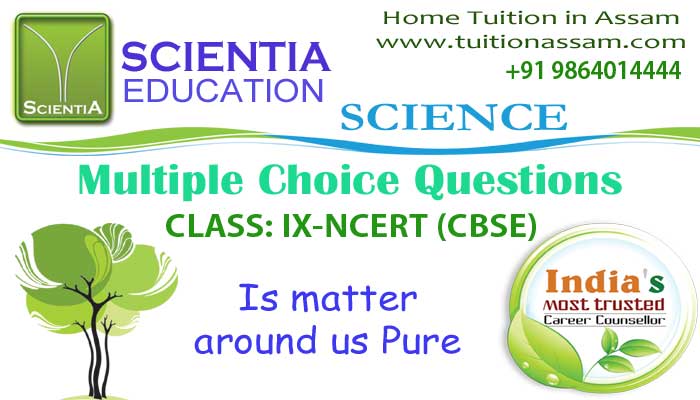
CLASS: IX NCERT (CBSE)
Chemistry
Is matter around us Pure (MCQ)
Question (1): A mixture of oil and water is an example of _____________.
1. compound
2. two elements
3. mixture
4. true solution
Ans: 3
Question (2): A mixture of mercury and copper is an example of _______.
1. solid and solid
2. liquid and solid
3. solid and liquid
4. liquid and liquid
Ans: 2
Question (3): Which of these elements is not a metalloid?
1. Tungsten
2. Germanium
3. Bismuth
4. Antimony
Ans: 1
Question (4): Which one of the following is monoatomic?
1. Oxygen
2. Hydrogen chloride gas
3. Argon
4. Ammonia
Ans: 3
Question (5): Which of the following is not a mixture?
1. Blood
2. Silver coins
3. Saliva
4. Plutonium
Ans: 4
Question (6): Which property does not describe a compound?
1. It is a pure substance.
2. It is mixed in any proportion by mass.
3. It cannot be separated into constituents by physical means.
4. It is composed of two or more elements.
Ans: 2
Question (7): The quantity of solute present in a given amount of solution represents_______
1. solubility
2. concentration
3. sublimity
4. saturation
Ans: 2
Question (8): In a colloidal solution________
1. the size of a colloidal particle lies roughly between 0.1 nm to 1 nm.
2. the particles have a tendency to settle when the solution is left standing.
3. the particles pass through ultrafilter papers and animal and vegetable membranes.
4. the dispersed phase is uniformly distributed in the dispersion medium
Ans: 4
Question (9): When sodium oxide reacts with water it undergoes chemical change to form ________.
1. hydrogen
2. sodium hydroxide
3. sodium nitride
4. sodium chloride
Ans: 2
Question (10): Chemical changes are __________.
1. temporary, reversible and a new substance is produced
2. always accompanied by exchange of light
3. permanent, irreversible and a new substance is produced
4. never accompanied by exchange of light and heat energy
Ans: 3
Question (11): Which pair is a miscible liquid mixture?
1. Methyl alcohol and acetone
2. Mercury and alcohol
3. Benzene and water
4. Carbon disulphide and water
Ans: 1
Question (12): Iron rod turns red on heating. The change is a______
1. physical change
2. temporary
3. physical and chemical change
4. chemical Change
Ans: 1
Question (13): Which one of the following does not sublime?
1. Camphor
2. Charcoal
3. Naphthalene
4. Iodine
Ans: 2
Question (14): Which technique is used to separate a solid-solid mixture?
1. Sedimentation
2. Evaporation
3. Distillation
4. Sublimation
Ans: 4
Question (15): On adding excess salt to a solution, it shows no change in solubility. This shows________
1. crystallization
2. slow Diffusion
3. saturation
4. dissolution
Ans: 3
Question (16): The process used to separate a mixture of ammonium chloride and iodine is ______.
1. sublimation
2. magnetic separation
3. solvent extraction
4. chromatography
Ans: 3
Question (17): An example of a chemical change is _____.
1. formation of clouds
2. glowing of an electric light
3. dropping sodium into water
4. dissolving of salt in water
Ans: 3
Question (18): A true solution is a _________.
1. homogeneous mixture
2. heterogeneous mixture
3. pure compound
4. impure compound
Ans: 1
Question (19): Fractional crystallization is used to separate which of the following?
1. Two solids
2. Two liquids
3. Two gases
4. A solid and a liquid
Ans: 1
Question (20): Tyndall Effect in colloids is due to _________.
1. dispersion of light
2. merging of light rays
3. scattering of light
4. convergence of light rays
Ans: 3













